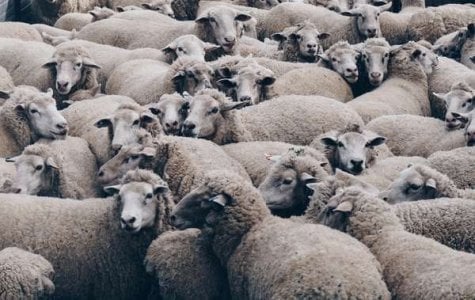Are Australian farmers giving their sheep away for ‘free’?
Australia's sheep farming industry is in a state of crisis, with prices plummeting to their lowest levels in 16 years, according to Bloomberg.
This has led to some farmers resorting to drastic measures, including giving away their sheep for free or even euthanising them to avoid the cost of care.
The current situation is a stark contrast to the record-high prices of lamb and mutton enjoyed by farmers less than three years ago.
The sudden downturn has left many farmers in despair, with older sheep fetching an average of just $34 in October. Mutton prices, on the other hand, have fallen 75 per cent over the past year.
There have even been cited instances of animals being sold for less than a dollar a head, according to Tim Jackson, a Global Supply analyst at Meat & Livestock Australia.
‘Some farmers are getting almost nothing,’ Andrew Spencer, Chair of Sheep Producers Australia, stated. ‘It’s been very volatile over the last couple of years.’
What is the root cause of this crisis? An oversupply of sheep.
Over the past three years, higher-than-average rainfall has led to abundant grass and forage for livestock. This has allowed farmers to significantly increase their sheep herds.
As a result, Australia now has an estimated 79 million sheep, about three times the human population, marking the country's largest number of sheep since 2007.
However, this boom in the sheep population has led to an oversupply, causing prices to plummet over the past year. Many abattoirs are at capacity, and farmers are struggling to find ways to decrease supply.
Mr Spencer shared that in some cases, where sheep are of low quality, farmers have resorted to giving animals away for free to pet food producers.
Adding to the industry's woes is the government's plan to phase out live sheep exports by sea, a practice considered by animal welfare groups to cause excessive and unnecessary suffering. This will mean farmers must reduce their sheep numbers, export them only by air, or slaughter sheep onshore before being shipped off.
While a date for this phase out plan has not yet been announced, the government has said it will not happen before 2025. This looming change has only added to the concerns of oversupply and further uncertainty in the industry.
In the meantime, the plight of Australia's sheep farmers serves as a sobering reminder of the challenges faced by those in the agricultural sector. It's a tough time for those on the land, and they need our support more than ever.
Here’s ABC News’ coverage of the issue:

What are your thoughts on this issue, members? Share your experiences and thoughts in the comments below.
This has led to some farmers resorting to drastic measures, including giving away their sheep for free or even euthanising them to avoid the cost of care.
The current situation is a stark contrast to the record-high prices of lamb and mutton enjoyed by farmers less than three years ago.
The sudden downturn has left many farmers in despair, with older sheep fetching an average of just $34 in October. Mutton prices, on the other hand, have fallen 75 per cent over the past year.
There have even been cited instances of animals being sold for less than a dollar a head, according to Tim Jackson, a Global Supply analyst at Meat & Livestock Australia.
‘Some farmers are getting almost nothing,’ Andrew Spencer, Chair of Sheep Producers Australia, stated. ‘It’s been very volatile over the last couple of years.’
What is the root cause of this crisis? An oversupply of sheep.
Over the past three years, higher-than-average rainfall has led to abundant grass and forage for livestock. This has allowed farmers to significantly increase their sheep herds.
As a result, Australia now has an estimated 79 million sheep, about three times the human population, marking the country's largest number of sheep since 2007.
However, this boom in the sheep population has led to an oversupply, causing prices to plummet over the past year. Many abattoirs are at capacity, and farmers are struggling to find ways to decrease supply.
Mr Spencer shared that in some cases, where sheep are of low quality, farmers have resorted to giving animals away for free to pet food producers.
Adding to the industry's woes is the government's plan to phase out live sheep exports by sea, a practice considered by animal welfare groups to cause excessive and unnecessary suffering. This will mean farmers must reduce their sheep numbers, export them only by air, or slaughter sheep onshore before being shipped off.
While a date for this phase out plan has not yet been announced, the government has said it will not happen before 2025. This looming change has only added to the concerns of oversupply and further uncertainty in the industry.
In the meantime, the plight of Australia's sheep farmers serves as a sobering reminder of the challenges faced by those in the agricultural sector. It's a tough time for those on the land, and they need our support more than ever.
Here’s ABC News’ coverage of the issue:
Key Takeaways
- Australian sheep farmers are facing a crisis due to a drastic 75 per cent drop in sheep prices, with some reports of animals selling for less than a dollar a head.
- The oversupply is largely due to three years of higher-than-average rainfall, which led to the country’s sheep population increasing to an estimated 79 million, the highest number since 2007.
- To combat the crisis, some farmers are reportedly giving away sheep for free or even euthanising them to avoid continued care at a loss.
- The Australian government’s plan to phase out live sheep exports by sea due to animal welfare concerns has intensified oversupply concerns, with a full phase-out not scheduled before 2025.
What are your thoughts on this issue, members? Share your experiences and thoughts in the comments below.








